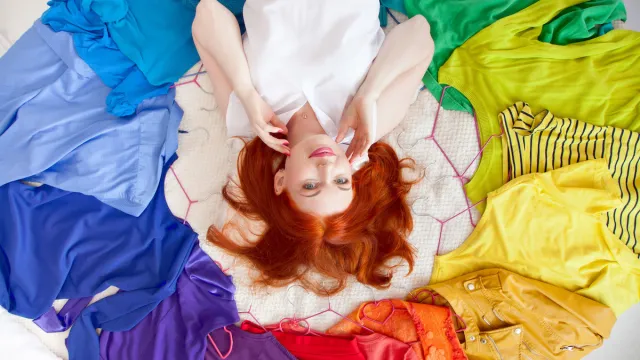6 Ways to Find Your Signature Color, According to Stylists

We’re always looking for shopping shortcuts—which means finding a signature color is right up our alley. But we’re not looking for just any hue. We’re looking for the unique shade that makes our skin look brighter, our eyes look bolder, and our hair look more vibrant. The one that makes strangers stop us on the street and say, “That’s your color.”
However, this mysterious shade isn’t always easy to find. In fact, it often takes a professional stylist to determine exactly which one is your ideal match. Here, we asked them to spill their secrets for finding a standout signature color. Read on for stylists’ amazing advice.
READ THIS NEXT: The Best Colors to Wear If You Have Blue Eyes, According to Stylists.
How to Find Your Signature Color
1. Take note of compliments.

Consider compliments as votes for your future signature color.
“When have you most often heard ‘that color looks great on you?’ Note that this is very different from someone saying they love the color,” says Jaquelyn Wahidi, a personal stylist in San Diego, California. “When you wear a flattering color, it makes you shine; when it’s just a color someone likes, they’re responding to the garment, not to you.”
You could also enlist an honest friend in your quest for your go-to hue. As you’re about to learn, it’s less of a science and more of an art, especially if you embark on the journey without a stylist.
2. Try Seasonal Color Analysis.

If you visit any personal stylist in search of your signature color, they’ll likely suggest Seasonal Color Analysis. During this practice, you’re draped in a series of color swatches and evaluated in each.
“These are indicators more than rules, plus exceptions and hybrids, which is why it’s best to hire a credentialed professional who is experienced in color analysis to ensure accuracy,” says Elizabeth Kosich, certified image stylist and founder of Elizabeth Kosich Styling.
“The best ones will require in-person sessions only to benefit from natural light and for the sake of precision as computer screens come with a high margin of error,” Kosich explains. Therefore, she suggests being wary of online color analysis deals.
READ THIS NEXT: The Best Colors to Wear If You Have Gray Hair, According to Stylists.
3. Learn your undertones.

If a visit to a stylist isn’t in the cards, there are ways to identify your undertones, and corresponding most-flattering colors, at home.
First, determine if your skin has a cool or warm undertone. Wahidi says you can look at the jewelry you gravitate toward to identify yours. If you look best in gold, you probably have warm undertones, while if you look better in silver, you’re likely cool.
The colors that look best on you will have an undertone that matches yours. “If it’s a warm hue, shades that have a yellow undertone will be great for you,” says personal stylist Niki Whittle. Think yellows, oranges, and red. “If it’s cool, colors that have a blue undertone will be best.” Think greens, blues, and purples.
4. Consider your hair and eye color.

Besides your skin tone, your hair and eye color can also cue you into your most flattering signature color.
Whittle explains that clothes that match your eye color will almost always have a showstopping effect.
When it comes to hair, you’ll want to consider its tone. “If it’s a warm hue, shades that have a yellow undertone will be great for you,” says Whittle. “If it’s cool, colors that have a blue undertone will be best.” Your hair stylist will be able to help you identify which end of the spectrum yours falls.
For more style advice delivered straight to your inbox, sign up for our daily newsletter.
5. Account for contrast.

Now that you know the basic colors that look best on you, it’s time to dial in on the exact hues that will make your features sing. That comes down to contrast.
“If there is a strong contrast between your features, you’ll look great in strong bold colors,” says Whittle. “But, if on the other hand, there is little contrast between your features, then you will look better in colors that are soft.”
For example, if you have deep, brown eyes and fair skin, then you have a high contrast. Whereas if you have light, hazel eyes and fair skin, then you have low contrast.
6. Take a look around your home and closet.

Still struggling to nail down your perfect hue? Scan the things you already own. Whittle says even your interior design tastes can clue you in.
“Look around your home, and note the colors you’ve surrounded yourself with,” she explains. “While we often struggle to choose clothes in colors that work for us, many of us subconsciously choose to fill our homes with our best colors!”
You can also note the colors you feel most confident in and decide if they’re worthy of being your signature. “We all have colors we love and colors we hate, and there is absolutely no point in wearing a color that suits you if you don’t like it,” adds Whittle. “Your signature color should be the balance between colors that suit you and colors you like.”